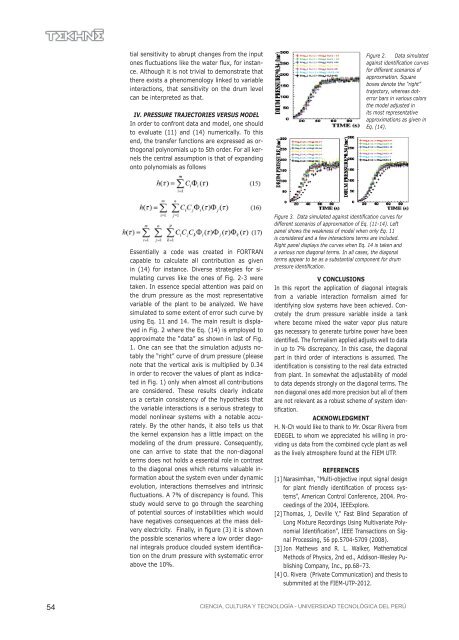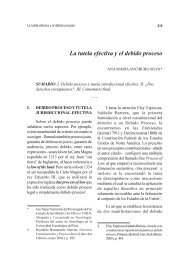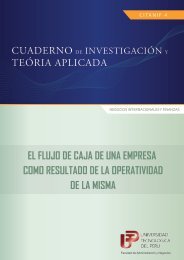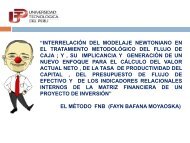Descargar - UTP
Descargar - UTP
Descargar - UTP
Create successful ePaper yourself
Turn your PDF publications into a flip-book with our unique Google optimized e-Paper software.
54<br />
tial sensitivity to abrupt changes from the input<br />
ones fluctuations like the water flux, for instance.<br />
Although it is not trivial to demonstrate that<br />
there exists a phenomenology linked to variable<br />
interactions, that sensitivity on the drum level<br />
can be interpreted as that.<br />
IV. PRESSURE TRAJECTORIES VERSUS MODEL<br />
In order to confront data and model, one should<br />
to evaluate (11) and (14) numerically. To this<br />
end, the transfer functions are expressed as orthogonal<br />
polynomials up to 5th order. For all kernels<br />
the central assumption is that of expanding<br />
onto polynomials as follows<br />
Essentially a code was created in FORTRAN<br />
capable to calculate all contribution as given<br />
in (14) for instance. Diverse strategies for simulating<br />
curves like the ones of Fig. 2-3 were<br />
taken. In essence special attention was paid on<br />
the drum pressure as the most representative<br />
variable of the plant to be analyzed. We have<br />
simulated to some extent of error such curve by<br />
using Eq. 11 and 14. The main result is displayed<br />
in Fig. 2 where the Eq. (14) is employed to<br />
approximate the “data” as shown in last of Fig.<br />
1. One can see that the simulation adjusts notably<br />
the “right” curve of drum pressure (please<br />
note that the vertical axis is multiplied by 0.34<br />
in order to recover the values of plant as indicated<br />
in Fig. 1) only when almost all contributions<br />
are considered. These results clearly indicate<br />
us a certain consistency of the hypothesis that<br />
the variable interactions is a serious strategy to<br />
model nonlinear systems with a notable accurately.<br />
By the other hands, it also tells us that<br />
the kernel expansion has a little impact on the<br />
modeling of the drum pressure. Consequently,<br />
one can arrive to state that the non-diagonal<br />
terms does not holds a essential role in contrast<br />
to the diagonal ones which returns valuable information<br />
about the system even under dynamic<br />
evolution, interactions themselves and intrinsic<br />
fluctuations. A 7% of discrepancy is found. This<br />
study would serve to go through the searching<br />
of potential sources of instabilities which would<br />
have negatives consequences at the mass delivery<br />
electricity. Finally, in figure (3) it is shown<br />
the possible scenarios where a low order diagonal<br />
integrals produce clouded system identification<br />
on the drum pressure with systematic error<br />
above the 10%.<br />
Figure 2. Data simulated<br />
against identification curves<br />
for different scenarios of<br />
approxmation. Square<br />
boxes denote the “right”<br />
trajectory, whereas doterror<br />
bars in various colors<br />
the model adjusted in<br />
its most representative<br />
approximations as given in<br />
Eq. (14).<br />
Figure 3. Data simulated against identification curves for<br />
different scenarios of approxmation of Eq. (11-14). Left<br />
panel shows the weakness of model when only Eq. 11<br />
is considered and a few interactions terms are included.<br />
Right panel displays the curves when Eq. 14 is taken and<br />
a various non diagonal terms. In all cases, the diagonal<br />
terms appear to be as a substantial component for drum<br />
pressure identification.<br />
V CONCLUSIONS<br />
In this report the application of diagonal integrals<br />
from a variable interaction formalism aimed for<br />
identifying slow systems have been achieved. Concretely<br />
the drum pressure variable inside a tank<br />
where become mixed the water vapor plus nature<br />
gas necessary to generate turbine power have been<br />
identified. The formalism applied adjusts well to data<br />
in up to 7% discrepancy. In this case, the diagonal<br />
part in third order of interactions is assumed. The<br />
identification is consisting to the real data extracted<br />
from plant. In somewhat the adjustability of model<br />
to data depends strongly on the diagonal terms. The<br />
non diagonal ones add more precision but all of them<br />
are not relevant as a robust scheme of system identification.<br />
ACKNOWLEDGMENT<br />
H. N-Ch would like to thank to Mr. Oscar Rivera from<br />
EDEGEL to whom we appreciated his willing in providing<br />
us data from the combined cycle plant as well<br />
as the lively atmosphere found at the FIEM <strong>UTP</strong>.<br />
REFERENCES<br />
[1] Narasimhan, “Multi-objective input signal design<br />
for plant friendly identification of process systems”,<br />
American Control Conference, 2004. Proceedings<br />
of the 2004, IEEExplore.<br />
[2] Thomas, J, Deville Y,” Fast Blind Separation of<br />
Long Mixture Recordings Using Multivariate Polynomial<br />
Identification”, IEEE Transactions on Signal<br />
Processing, 56 pp.5704-5709 (2008).<br />
[3] Jon Mathews and R. L. Walker, Mathematical<br />
Methods of Physics, 2nd ed., Addison-Wesley Publishing<br />
Company, Inc., pp.68–73.<br />
[4] O. Rivera (Private Communication) and thesis to<br />
submmited at the FIEM-<strong>UTP</strong>-2012.<br />
CIENCIA, CULTURA Y TECNOLOGÍA - UNIVERSIDAD TECNOLÓGICA DEL PERÚ
















